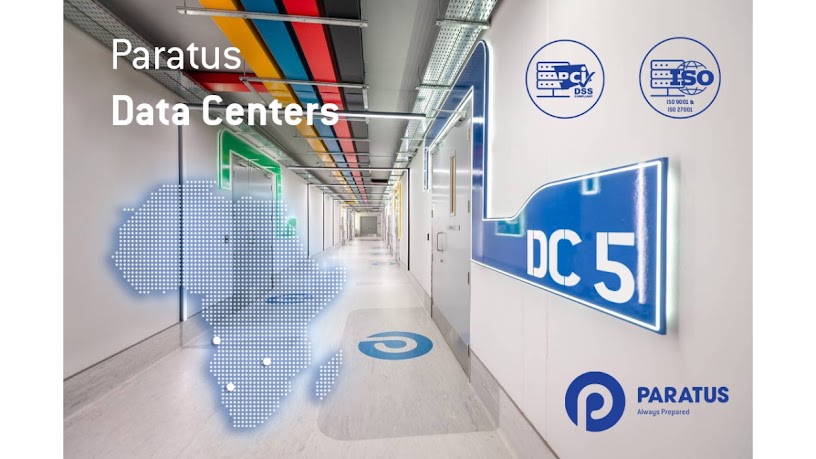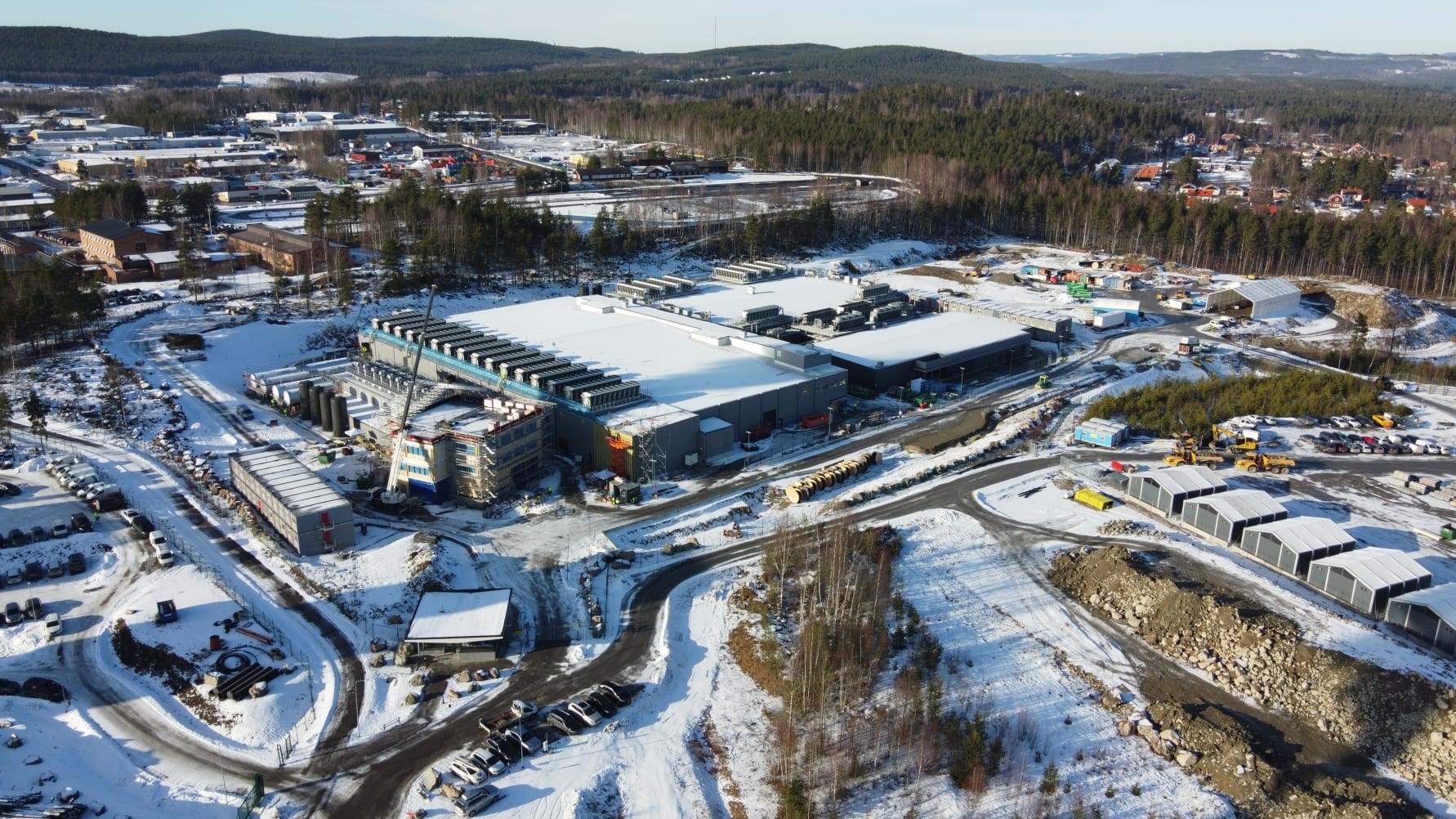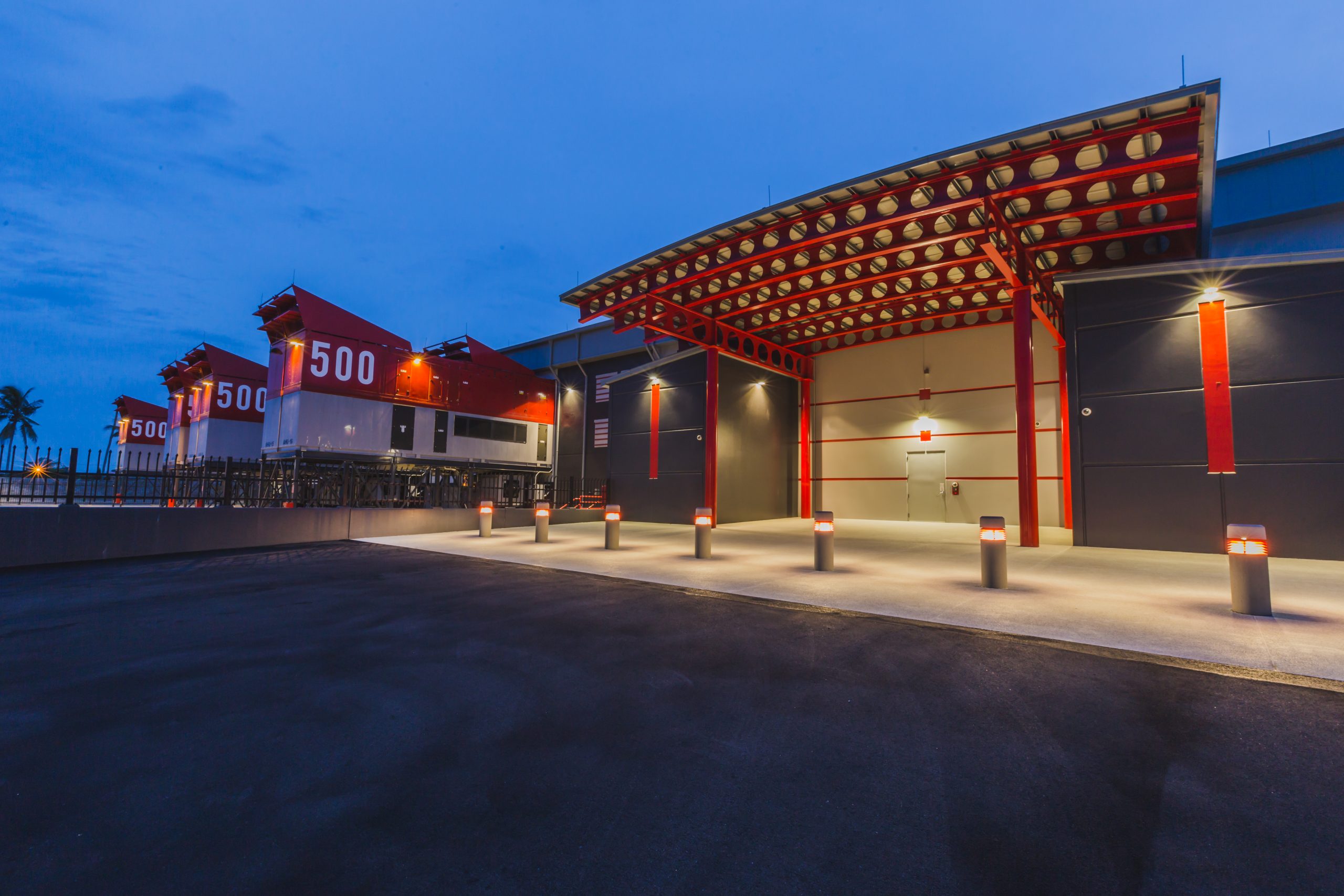Colocation
Colocation
Data Centres
Infrastructure
Infrastructure Management
The Paratus Group announces new data centres in Angola
The Paratus Group is celebrating 20 years in Africa by announcing it will construct Angola’s first Tier-IV by design data centre in Luanda. This complements the existing two Tier-III by design data centres that the pan-African telco already owns and operates in Angola. It is the fifth certified and carrier neutral data centre operated by the company in Southern Africa.
Chief Technical Officer at Paratus, Rolf Mendelsohn, who is participating at the Pan-African data centre exhibition and conference as a panellist, says, “The new data centre will be constructed on a 30,000m2 plot, will have the capacity to house over 2,000 cabinets, and will have a total IT power capacity of more than 10MW. It is a natural evolution after having built other world-class data centre facilities in Namibia and Zambia recently. It will be the biggest data centre in Angola and not only complements our existing data centre offering, but will cement our network in Angola as a major hub in the region.”
The company currently has four Tier-III by design data centres in Southern Africa. With the opportunities presented by the activation of the Equiano subsea cable and by the growing digital economy, it has established itself as a player in igniting the possibilities for hyperscalers, cloud and infrastructure providers and multinational enterprises.
Rolf adds, "Colocation of critical infrastructure in data centres is becoming indispensable to businesses wanting a digital economy advantage. We will support this by providing the necessary infrastructure and services to give businesses what they need to actively compete in the fourth industrial revolution (4IR).”
The company owns and operates data centres in Angola, Namibia and Zambia. All Paratus data centres have been ISO 9001, ISO 27001 and PCI-DSS certified.
Isha Jain - 30 June 2023
Cloud
Colocation
Data
Colt launches multicast data in the cloud for capital markets
Colt Technology Services has announced the global availability of Colt Market Data in the Cloud with Amazon Web Services (AWS). The service solves a complex challenge for exchanges, prime brokers, trading firms, market data vendors and technology providers - by hosting and distributing multicast data in the cloud without the need for conversion software.
Now capital markets can experience the benefits of cloud, without being held back by cloud service providers’ inability to support critical applications. The launch follows a successful Proof of Concept announced by Colt and AWS in October 2022, which saw the companies build virtual distribution Points of Presence (PoPs) in the AWS Cloud.
Colt provides market data feeds for equities, derivatives, commodities and FX from more than 80 exchanges and liquidity venues worldwide. Securely sending this market data to multiple parties simultaneously is a key requirement for financial exchanges, but getting this data to clients’ cloud environments is complex. Existing solutions typically require conversion software to change data from multicast to unicast, adding cost and complexity as organisations rewrite and retest applications. As more and more capital market firms migrate to the cloud, the problem becomes widespread. Colt Market Data in the Cloud solves this, enabling organisations to securely host and distribute raw multicast data directly to their customers’ cloud environments in its original format, ensuring seamless integration with applications, facilitating faster times to market and improving the client experience.
At the same time, organisations benefit from end-to-end market data monitoring: the company monitors data at the source, within the exchange colocation; in transit, as it moves through the network; and within the virtual Point of Presence.
The launch supports the financial market’s transition to on-demand services and automation of real-time raw data and trading applications.
Isha Jain - 30 June 2023
Colocation
Data Centres
Infrastructure Management
Cologix expands partnership with Montreal Internet Exchange
Cologix has announced an expansion with the Montreal Internet Exchange (QIX) to establish an additional Point of Presence (PoP) in the Cologix MTL7 digital edge data centre. This expanded partnership enables valuable interconnection access for businesses in the Montreal region.
QIX has maintained a presence in Cologix facilities for over a decade, serving as a hub for internet, peering at its MTL1 and MTL3 digital edge data centres. Internet exchanges like QIX play a pivotal role in the value of the company’s ecosystem by enabling scalable peering and broad access to a diverse collection of networks.
“This growing partnership between QIX and Cologix is driven by a shared mission to streamline the sharing of internet traffic to empower digital ecosystems at the edge,” says Peg Hallberg, Cologix’s Head of Product. “Our MTL7 facility now provides customers an environment to natively connect and exchange traffic with peering members. Businesses can directly connect to the QIX exchange in MTL7, enabling customers to expand their reach and improve network performance while fostering a dynamic digital ecosystem.”
MTL7 is 26,000ft², located in downtown Montreal and connected to the MTL3 carrier hotel facility and 10 additional data centres across the city via Metro Connect. All of the data centres are ISO 27001 certified by Schellman and HIPAA, SOC1, SOC2 and PCI compliant.
“Our new PoP at MTL7 makes peering easier than ever before by enabling networks within the data centre to seamlessly connect to QIX,” says Stephano Bertini, Vice President, Business Development and General Manager at QIX. “By eliminating an extra layer of connectivity, QIX ensures enhanced accessibility and facilitates more efficient and cost-effective peering options for businesses colocated at MTL7.”
Isha Jain - 30 June 2023
Colocation
Data Centres
KDDI expands data centre presence in North America
KDDI Corporation, together with Telehouse, has announced the latest expansion of its global footprint in North America by reaching an agreement with Allied Properties REIT to acquire three data centres and its accompanying assets in Toronto, Canada. This investment of CAD1.35bn comes as a result of increased demand in the market for reliable interconnectivity services.
Starting with the first Telehouse data centre in New York in 1989, KDDI has been continuously expanding its presence in new markets for over 30 years, with this recent acquisition bringing the total portfolio of data centres to 12 countries. The new carrier-neutral data centres are located in the city centre of Toronto, and when fully operational will provide over 30MW of IT load.
Its new data centres will provide both shared and dedicated space to fulfil customer needs, especially those expanding internationally that require a highly trusted partner to establish their IT environment. Businesses wishing to collocate from the new locations will gain access to a variety of connectivity partners, including carriers, ISPs, ASPs, and large private and public cloud service providers, to extend network reach, reduce latency and costs, and improve performance.
Michael Emory, Founder and Executive Chair, Allied Properties REIT, says, “With global data centre operating capability, KDDI is an ideal successor owner for our data centre assets. Canadian cities continue to grow dramatically and successfully. The growth is driven in large part by knowledge-based organisations that require sophisticated and wide-ranging connectivity solutions. KDDI is extremely well-positioned to provide these solutions and, in doing so, contribute meaningfully to the many and varied businesses operating in our cities.”
Isha Jain - 21 June 2023
Cloud
Colocation
Data Centres
News
DE-CIX announces its newest expansion in Denmark
DE-CIX has pushed its expansion forward with its newest internet exchanges in Esbjerg and Copenhagen, Denmark. The IXs are now ready for service in the data centres of Bulk Data Centers and Digital Realty, with more enabled sites to be announced in due course.
These internet exchanges are based on the DE-CIX Apollon interconnection and cloud platform, which includes cloud routing services for companies to manage their hybrid and multi-cloud scenarios and gain control of their data beyond the public internet. With the approach of one access, all clouds, and every network, it is bringing its InterconnectionFLEX service to Denmark, providing enterprises with an interconnection package as a solution for peering, cloud connectivity, and private network interconnects.
Customers can have direct access to over 50 clouds, 2,000+ local and international networks, and over 250 data centres in Germany, Southern Europe, Asia, and the US. In addition, it will act as a digital hub for regional connectivity, enabling local networks low-latency interconnection and the localisation of global content, while increasing network stability, scalability, and security. The platform also offers advanced service features and automation, including access to the DE-CIX self-service portal and the DE-CIX API.
“DE-CIX is proud to provide interconnection services in Denmark, bringing our state-of-the-art platform to a highly digitalised society. By interconnecting our Danish platform with not only our Nordic ecosystem, but also with our interconnection platforms in the Central and Southern European, and North American markets, it offers Denmark access to the largest data centre and carrier neutral interconnection ecosystem. DE-CIX is here to serve interconnection requirements of Danish enterprises, today and in the future,” says Ivo Ivanov, CEO of DE-CIX.
“We’re delighted to have the opportunity to work with DE-CIX and provide its members with access to a wide range of colocation and connectivity solutions, including direct connections to the world’s major cloud providers. Through our data centre platform, PlatformDIGITAL, businesses will benefit from low-latency, secure access to companies such as Amazon Web Services (AWS), Microsoft Azure, and Google Cloud, helping to reduce costs, improve efficiency, and ultimately, support them as they continue their digital transformation journeys,” says Pernille Hoffman, Managing Director, Digital Realty in the Nordics.
“Our partnership with DE-CIX will give local and international customers the option to interconnect and access a range of services in major markets with even lower latency. By strategically locating our data centre in Esbjerg, we leverage the advantages of a close proximity to continental Europe and robust fibre connectivity to the US. We are seeing an increase in demand for low-cost, highly sustainable solutions and with these new DE-CIX Nordics locations we are helping to support that gravity shift north, where you find the greenest energy in Europe,” says Gisle M. Eckhoff, Executive Vice President, Data Centres at Bulk Infrastructure Group.
Isha Jain - 15 June 2023
Colocation
Data Centres
Energy Management
The University of York moves data to Sweden to reach net zero
As part of its ambition to reach net zero, the University of York will place much of the university’s advanced calculations at EcoDataCenter in Falun, Sweden. Access to sustainable infrastructure for the most energy-consuming part of IT has been the determining factor.
"Given the university’s strong commitment to net zero and the fact that our high-performance computing facility will be used for climate research, we were happy to find a partner with a clear focus on environmental sustainability and the capability and maturity to deliver," says Richard Fuller, Assistant Director at the University of York.
The need for more data will increase by 300% over the next few years. AI and Machine Learning are part of the concept of High-Performance Computing and are by far the most energy-consuming data, and will constitute the majority of the data growth. A sustainable digital infrastructure that can handle the growing amount of data is vital for the green transition.
When the university began looking at the next iteration of its High-Performance Computing facility, it realised that finding a colocation facility that could fulfil its requirements would be a great challenge. Turning to the Nordic countries, the university identified EcoDataCenter as a facility that meets both its needs and values. By placing the data in EcoDataCenter in Falun, the university is able to reduce carbon emissions from the data by about 98%, compared to handling the same data in the UK.
Apart from EcoDataCenter in Sweden, being the place where the University of York is carrying out its calculations, the parties will also jointly work to raise knowledge about increased requirements for sustainability in the area of High-Performance Computing. Lack of knowledge about sustainable solutions, demands for innovation and speed often lead to sustainability being deprioritised.
“Sustainable research IT is a key principle of the University of York. In addition to optimising the performance of both hardware and software, we need to look at the environmental impact of our work. We have to ask ourselves how we can contribute to positive change by making our supercomputing part of the ‘Green HPC’ movement,” says Dr Emma Barnes, Head of Research IT at the University of York.
Due to the cool climate, the cost of green energy and the availability of labour, Sweden is an attractive country when it comes to data centre establishments. However, EcoDataCenter sees that many companies and organisations are turning to Sweden to learn more about the possibilities of sustainability from a broader perspective than just green energy.
"When the University of York visited our facility in Falun to learn more about how we construct data centres and how we view the role of data centres in society and the circular economy, we found a common agenda in accelerating the green transition in digitalisation. The collaboration has already started, and we are seeing even more universities interested in what we can offer," says Dan Andersson, CEO at EcoDataCenter.
Isha Jain - 8 June 2023
Colocation
Colocation
Data Centres
Telehouse Europe powers operational and customer experience with series of senior appointments
Global colocation provider, Telehouse International Corporation of Europe, has strengthened its operational and customer experience excellence with a restructuring of its operations department and five new appointments, including two new members to the board of directors.
Previously holding the Senior Director of Customer Experience position, Mark Pestridge has been promoted to the role of Executive Vice President and General Manager with the responsibility of informing and supporting the work of the board, including leading the organisation’s short and long term strategies and overseeing the operations of the business globally. With over 20 years’ experience in the data centre and service provider space, Mark has a solid history of developing strategic partnerships across the industry that achieve strong and consistent business performance.
Joining Mark on the Board of Directors as Senior Vice President and Leader of Technical Services is Paul Lewis, former Senior Director of Technical Services, who led the Operational, Construction, and Design Departments at Telehouse. Paul also takes on responsibility for informing and supporting the work of the board, including the setting of the global vision and strategy, delivering of the agreed strategy, overseeing the company’s entire operations and optimising the organisation’s operational capabilities.
The restructure of the Telehouse Europe operations department sees the creation of a new Data Centre Services Department, aimed at providing efficient and secure services to its customers. This department is managed by a newly appointed Data Centre Services Senior Director, Scott Longhurst.
Scott joined Telehouse in February this year and has over 30 years’ experience in critical infrastructure management and engineering in the data centre and telecommunications industry. In his new role, Scott will ensure that the global colocation provider can continue to build a culture of continuous improvement that places customers at the heart of all its business operations and customer experience initiatives.
Telehouse’s new Data Centre Services Department is comprised of three key focus areas, Data Centre Operations headed by newly appointed Alex Mason, and Security Services and Service Delivery headed by Rob Rennie and Simon Smith respectively.
Alex, who joined Telehouse in April, focuses on the management and strategic vision of Telehouse’s mission critical facilities environments. He is also responsible for the day-to-day service management and maintenance of all infrastructure, including building and facilities management, on a 24/7 basis.
Rob, who has been promoted to Security Services Director, oversees the management and strategic vision of Telehouse’s physical security including the security of the colocation provider’s assets and those of its customers. He is responsible for evaluating risks to Telehouse and its customers and ensuring that robust procedures are in place to mitigate these risks and for driving efficiencies and ongoing improvement of security systems and processes.
As the newly promoted Service Delivery Director, Simon takes on the Service Desk responsibility, installation of all white space client solutions such as cage and rack builds, power connections, interconnection cabling, campus wide ducts and interconnection of the Data Centres.
Takayo Takamuro, Managing Director & European Chief Executive of Telehouse Europe, commented, “We’re undergoing a transformation of Telehouse that will help us achieve greater operational and customer experience excellence. The new Data Centre Services Department will help us enhance our ability to respond to changing customer needs proactively and ensure ongoing enhancement of the customer journey through end-to-end services. As a global colocation provider known for its unrivalled connectivity, we continuously strive to drive our interconnection strategy forward and into new areas, with all the newly appointed senior members supporting the business to achieve this goal.”
Isha Jain - 6 June 2023
Colocation
Data Centres
News
Power & Cooling
i3 Solutions Group secures patents for greater data centre resiliency
i3 Solutions Group has been issued two patents by the USPTO (US Patent and Trademark Office) for its Adaptable Redundant Power (ARP) topology control solution for mission-critical electrical power systems.
ARP is a hardware and software control system that overcomes the inflexibility of common data centre electrical designs, solving the service level agreement (SLA) disparity problem whereby power supply chain systems are fixed but IT load demands, and criticality are variable.
At the same time, ARP addresses constraints associated with traditional static power topologies which can restrict access to available data centre power, often leaving costly stranded capacity unused and increasing end user costs. This is an acute challenge for the wholesale colocation industry, which does an admirable job securing and deploying grid power capacity, but is often unable to fully or optimally utilise it - causing energy waste and higher costs.
Benefits of ARP
Ed Ansett, Founder and Chairman of i3 Solutions Group, says, “Every business has low to high levels of application criticality and interdependency. Through developments such as Kubernetes, IT can be orchestrated to reflect this. However, when it comes to electricity, the power chain is fixed, wasteful and difficult to change. ARP is a way to flex the power SLA to match the IT workload SLA without the considerable expense of rewiring the entire topology design.”
By enabling power service levels to be aligned with that of the IT load, ARP provides a range of benefits to both data centre operators and their IT customers. ARP enables applications and the hardware they sit on to be provisioned with varying levels of electrical power resilience.
Today, it is obvious that not all IT workloads are equal - for example, a dev ops project for a marketing campaign versus live financial transactions workloads in retail or merchant bank, or a network rack compared with a super compute cluster. However, the way power is delivered using a fixed topology does not differentiate in terms of criticality, treating all workload destinations equally.
ARP is different because it can automatically provide power resilience across the topology that is dynamically matched to the criticality of the IT load.
ARP solves inherent redundant power challenges too
Traditionally power chain designs for data centres are based on a chosen level of capacity, resilience and redundancy of N, N+1, N+2 and less commonly 2N, 2N+1 and 2(N+1). But once the topology is decided and deployed it is fixed. It is then expensive, time consuming and extremely difficult to change. ARP addresses this.
ARP can also provide Inherent Redundant Power (IRP). Where some electrical designs leave ‘power pockets’ (assigned power that is unused) - IRP accesses previously trapped or stranded power and prevents it going to waste by utilising it to provide additional levels of redundancy.
Power-as-a-Service offers from colocation data centres one step closer
ARP offers colocation data centres the opportunity to create new business models based on their power infrastructure. One of the advantages, for example, is that ARP enables a staggered approach to infrastructure roll out which responds to end-user load and not design criteria.
By treating power as a service right from the construction phase, ARP addresses many flexibility issues which have surfaced for modern data centre operators. While data centres will continue to be designed as physical buildings which are broken down into halls, ARP modules are flexible enough to provide power across multiple halls.
ARP therefore enables developers to move away from traditional and capitally intense methods of infrastructure deployment - up-front design, source, pay for and roll-out the full site requirement for genset, switchgear, UPS, PDU and ancillary equipment, and then wait for the demand to arrive.
Beatrice - 28 April 2023
Colocation
Data Centres
Events
Infrastructure
News
Green data centres for Thailand’s sustainable economic growth
Under the theme ‘Open. Connect. Balance’, Thailand recently hosted ASEAN leaders at the 2022 APEC Summit, and among many current unprecedented challenges discussed, helping the region regain its balance seemed to be a common thread, with the Bangkok Goals on Bio-Circular-Green (BCG) Economy set as one of the roadmaps. As one of the fastest growing regions in the world - and one of the most vulnerable to climate change - Southeast Asia is trying to strike a balance between performance and sustainability: prioritising recovery and growth, while keeping the eyes on a consistent sustainable development that will allow the country to thrive for many years to come.
Digital transformation, integrated across all aspects of society, has already been identified as one of the key components to driving the country’s overall economic competitiveness, and many already understand that there is only one way to embrace Thailand 4.0 sustainably. Many industries are gradually ‘going green’, including green finance, green transportation powered by EVs and green hotel standards. Now comes the turn for one of the most valuable assets that this revolution will bring - data.
Thailand is leading the way, not only by having the region’s most advanced data centre for colocation and cloud services, but also by having one that generates its own renewable energy. SUPERNAP (Thailand), a joint venture between leading Thai companies, is the only Tier IV colocation and cloud data centre in the country to have implemented a solar panel farm. This move contributes to the development of the green digital infrastructure of the region, while also supporting Thailand’s long term sustainable economic development.
Every year, the volume and value of data generated and collected by organisations in Thailand grows exponentially, as many recognise its strategic value for business decisions. The more data collected and stored, the more knowledge, opportunities and competitive advantage businesses gain. More data, on the other hand, requires larger spaces and more energy to keep the ecosystem running, which, in most cases, comes from electricity from fossil fuels. If no action is taken, this could not only lead to a problematic increase of greenhouse gas emissions, but to dangerous price fluctuations, as there have been recent electricity price increases influenced by geopolitical challenges and increasing demand. Thai businesses are looking for secure, scalable, resilient, and now sustainable, data centres to fully realise the potential of data while reducing costs.
“As a regional digital infrastructure leader, SUPERNAP (Thailand)’s transition to renewable energy was already an urgent priority, and we are now extremely proud to have reinforced our position as Thailand’s most sustainable commercial data centre. Powering operations by solar panel farm will not only help us reduce carbon footprint on behalf of our colocation and cloud clients but will also minimise the impact of energy price fluctuations. While we are not immune to rising electricity costs, solar green energy from the solar panel farm is significantly cheaper than retail rates, which will allow us keep prices as low as possible, an ultimately enable customer's success stories with highly secure, scalable, resilient and now sustainable digital IT infrastructure,” shares Yap Jin Yi, CEO of SUPERNAP (Thailand).
SUPERNAP (Thailand) has partnered with WHA Utilities and Power to build its solar panel farm, recognising WHA’s leadership in maximising innovation and technology to create long term sustainable value in the country.
Thailand’s economy will leverage emerging digital technologies to solve the most pressing problems and drive growth, whether in finance, retail, healthcare, manufacturing or tourism. Data-driven technology has the potential to shape the future in new and unimaginable ways, but first, businesses and individuals must ensure that there is a future to look forward to. Embracing sustainability is a pressing matter, and change must begin immediately.
Beatrice - 22 November 2022
Colocation
Data Centres
Colt drives forward cloud colocation for capital markets
Colt Technology Services has announced the successful completion of a pioneering cloud colocation Proof of Concept (PoC), which demonstrates the viability of hosting and distributing multicast data in the cloud for global capital market customers. The testing represents a step towards greater services and automation for real-time raw data and trading applications, bringing capital market customers closer to leveraging the full benefits of the cloudification of market data.
In the PoC, Colt worked with Amazon Web Services (AWS) to build virtual distribution Points of Presence (PoPs) in the AWS Cloud. This allows customers to lift and shift applications onto the cloud without the need for any physical infrastructure. This means services can be deployed rapidly, reducing service delivery SLAs from the usual weeks or months of traditional physical colocation in the exchange, to just days.
Arthur Rank, Global Director, Capital Market Solutions for Colt, says: “Capital market customers across the globe have increasingly been looking to the cloud to drive their digital transformations, but until now they have been limited by the inability of cloud service providers to facilitate multicast. The success of this PoC presents a huge opportunity for capital markets to move as many workloads into the cloud as possible and truly leverage the flexibility, agility and speed of the cloud.
“Colt has long been the leading connectivity provider for global capital markets and this ground-breaking PoC demonstrates our commitment to providing innovative, market-leading services to the global market,” he adds.
Beatrice - 19 October 2022

Head office & Accounts:
Suite 14, 6-8 Revenge Road, Lordswood
Kent ME5 8UD
T: +44 (0)1634 673163
F: +44 (0)1634 673173









